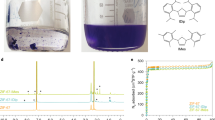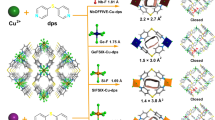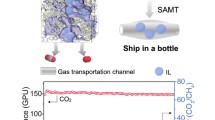Abstract
Porous liquids (PLs), an emerging porous material with permanent cavities, have attracted extensive attention in recent years. However, the current construction methods are complicated and resulting PLs possess high viscosity values, which cannot meet the requirements of practical industrial applications. Herein, we demonstrate a generalizable and simple strategy to prepare type III PLs with low viscosity based on the rule of “like dissolves like”. Specifically, the monoglycidyl ether terminated polydimethylsiloxane (denoted by E-PDMS) is attached to the surface of Universitetet i Oslo (UiO)-66-NH2 via covalent linkage, constructing the pore generator (UiO-66-NH2-E-PDMS, denoted by P-UiO-66). Then, P-UiO-66 is dispersed into different types and amounts of sterically hindered solvents (PDMS400 or PDMS6000), obtaining a series of type III PLs (denoted by P-UiO-66-PLs) with permanent cavities and low viscosities. The gas sorption-desorption test shows that P-UiO-66-PLs have an enormous potential for CO2/N2 selective separation. Besides, the porosity of P-UiO-66-PLs and the CO2 sorption mechanism are demonstrated by molecular simulation. Furthermore, the generality of the synthesis strategy is confirmed by the successful construction of PLs using two other amino-metal-organic frameworks (MOFs) (MIL-53(Al)-NH2 and MIL-88B(Fe)-NH2). Importantly, it’s worth noting that the strategy based on the rule of “like dissolves like” sheds light on the preparation of other types of PLs for task-specific applications.

Similar content being viewed by others
References
Rogelj, J.; den Elzen, M.; Höhne, N.; Fransen, T.; Fekete, H.; Winkler, H.; Schaeffer, R.; Sha, F.; Riahi, K.; Meinshausen, M. Paris Agreement climate proposals need a boost to keep warming well below 2 °C. Nature 2016, 534, 631–639.
Harper, A. B.; Powell, T.; Cox, P. M.; House, J.; Huntingford, C.; Lenton, T. M.; Sitch, S.; Burke, E.; Chadburn, S. E.; Collins, W. J. et al. Land-use emissions play a critical role in land-based mitigation for Paris climate targets. Nat. Commun. 2018, 9, 2938.
Seneviratne, S. I.; Rogelj, J.; Séférian, R.; Wartenburger, R.; Allen, M. R.; Cain, M.; Millar, R. J.; Ebi, K. L.; Ellis, N.; Hoegh-Guldberg, O. et al. The many possible climates from the Paris Agreement’s aim of 1.5 °C warming. Nature 2018, 558, 41–49.
Hepburn, C.; Adlen, E.; Beddington, J.; Carter, E. A.; Fuss, S.; Mac Dowell, N.; Minx, J. C.; Smith, P.; Williams, C. K. The technological and economic prospects for CO2 utilization and removal. Nature 2019, 575, 87–97.
Solomatova, N. V.; Caracas, R.; Manning, C. E. Carbon sequestration during core formation implied by complex carbon polymerization. Nat. Commun. 2019, 10, 789.
Kim, E. J.; Siegelman, R. L.; Jiang, H. Z. H.; Forse, A. C.; Lee, J. H.; Martell, J. D.; Milner, P. J.; Falkowski, J. M.; Neaton, J. B.; Reimer, J. A. et al. Cooperative carbon capture and steam regeneration with tetraamine-appended metal-organic frameworks. Science 2020, 369, 392–396.
Boyd, P. G.; Chidambaram, A.; García-Díez, E.; Ireland, C. P.; Daff, T. D.; Bounds, R.; Gładysiak, A.; Schouwink, P.; Moosavi, S. M.; Maroto-Valer, M. M. et al. Data-driven design of metal-organic frameworks for wet flue gas CO2 capture. Nature 2019, 576, 253–256.
Yu, J. M.; Xie, L. H.; Li, J. R.; Ma, Y. G.; Seminario, J. M.; Balbuena, P. B. CO2 capture and separations using MOFs: Computational and experimental studies. Chem. Rev. 2017, 117, 9674–9754.
Trickett, C. A.; Helal, A.; Al-Maythalony, B. A.; Yamani, Z. H.; Cordova, K. E.; Yaghi, O. M. The chemistry of metal-organic frameworks for CO2 capture, regeneration and conversion. Nat. Rev. Mater. 2017, 2, 17045.
Li, Y.; Wang, Y. T.; Fan, W. D.; Sun, D. F. Flexible metal-organic frameworks for gas storage and separation. Dalton Trans. 2022, 51, 4608–4618.
Wang, Y. T.; Fu, M. Y.; Zhou, S. N.; Liu, H. Y.; Wang, X. K.; Fan, W. D.; Liu, Z. N.; Wang, Z. K.; Li, D. C.; Hao, H. G. et al. Guest-molecule-induced self-adaptive pore engineering facilitates purification of ethylene from ternary mixture. Chem 2022, 8, 3263–3274.
Fan, W. D.; Ying, Y. P.; Peh, S. B.; Yuan, H. Y.; Yang, Z. Q.; Yuan, Y. D.; Shi, D. C.; Yu, X.; Kang, C. J.; Zhao, D. Multivariate polycrystalline metal-organic framework membranes for CO2/CH4 separation. J. Am. Chem. Soc. 2021, 143, 17716–17723.
Fan, W. D.; Yuan, S.; Wang, W. J.; Feng, L.; Liu, X. P.; Zhang, X. R.; Wang, X.; Kang, Z. X.; Dai, F. N.; Yuan, D. Q. et al. Optimizing multivariate metal-organic frameworks for efficient C2H2/CO2 separation. J. Am. Chem. Soc. 2020, 142, 8728–8737.
Fan, W. D.; Wang, X.; Zhang, X. R.; Liu, X. P.; Wang, Y. T.; Kang, Z. X.; Dai, F. N.; Xu, B.; Wang, R. M.; Sun, D. F. Fine-tuning the pore environment of the microporous Cu-MOF for high propylene storage and efficient separation of light hydrocarbons. ACS Cent. Sci. 2019, 5, 1261–1268.
Heldebrant, D. J.; Koech, P. K.; Glezakou, V. A.; Rousseau, R.; Malhotra, D.; Cantu, D. C. Water-lean solvents for post-combustion CO2 capture: Fundamentals, uncertainties, opportunities, and outlook. Chem. Rev. 2017, 117, 9594–9624.
Zeng, S. J.; Zhang, X. P.; Bai, L.; Zhang, X. C.; Wang, H.; Wang, J. J.; Bao, D.; Li, M. D.; Liu, X. Y.; Zhang, S. J. Ionic-liquid-based CO2 capture systems: Structure, interaction and process. Chem. Rev. 2017, 117, 9625–9673.
Zhao, M.; Minett, A. I.; Harris, A. T. A review of techno-economic models for the retrofitting of conventional pulverised-coal power plants for post-combustion capture (PCC) of CO2. Energy Environ. Sci. 2013, 6, 25–40.
Yu, C. H.; Huang, C. H.; Tan, C. S. A review of CO2 capture by absorption and adsorption. Aerosol Air Qual. Res. 2012, 12, 745–769.
O’Reilly, N.; Giri, N.; James, S. L. Porous liquids. Chem. —Eur. J. 2007, 13, 3020–3025.
Wang, D. C.; Xin, Y. Y.; Yao, D. D.; Li, X. Q.; Ning, H. L.; Zhang, H. M.; Wang, Y. D.; Ju, X. Q.; He, Z. J.; Yang, Z. Y. et al. Shining light on porous liquids: From fundamentals to syntheses, applications and future challenges. Adv. Funct. Mater. 2022, 32, 2104162.
Fulvio, P. F.; Dai, S. Porous liquids: The next frontier. Chem 2020, 6, 3263–3287.
Avila, J.; Lepre, L. F.; Santini, C. C.; Tiano, M.; Denis-Quanquin, S.; Chung Szeto, K.; Padua, A. A. H.; Costa Gomes, M. High-performance porous ionic liquids for low-pressure CO2 capture. Angew. Chem., Int. Ed. 2021, 60, 12876–12882.
Yang, M. K.; Wang, H. S.; Zuo, J. Y.; Deng, C.; Liu, B.; Chai, L. Y.; Li, K.; Xiao, H.; Xiao, P.; Wang, X. H. et al. Efficient separation of butane isomers via ZIF-8 slurry on laboratory-and pilot-scale. Nat. Commun. 2022, 13, 4792.
Wang, D. C.; Xin, Y. Y.; Li, X. Q.; Ning, H. L.; Wang, Y. D.; Yao, D. D.; Zheng, Y. P.; Meng, Z. Y.; Yang, Z. Y.; Pan, Y. T. et al. Transforming metal-organic frameworks into porous liquids via a covalent linkage strategy for CO2 capture. ACS Appl. Mater. Interfaces 2021, 13, 2600–2609.
Wang, D. C.; Xin, Y. Y.; Li, X. Q.; Wang, F.; Wang, Y. D.; Zhang, W. R.; Zheng, Y. P.; Yao, D. D.; Yang, Z. Y.; Lei, X. F. A universal approach to turn UiO-66 into type 1 porous liquids via post-synthetic modification with corona-canopy species for CO2 capture. Chem. Eng. J. 2021, 416, 127625.
Xin, Y. Y.; Wang, D. C.; Yao, D. D.; Ning, H. L.; Li, X. Q.; Ju, X. Q.; Zhang, Y. C.; Yang, Z. Y.; Xu, Y. H.; Zheng, Y. P. Post-synthetic modification of UiO-66-OH toward porous liquids for CO2 capture. New J. Chem. 2022, 46, 2189–2197.
Liu, H.; Liu, B.; Lin, L. C.; Chen, G. J.; Wu, Y. Q.; Wang, J.; Gao, X. T.; Lv, Y. N.; Pan, Y.; Zhang, X. X. et al. A hybrid absorptionadsorption method to efficiently capture carbon. Nat. Commun. 2014, 5, 5147.
Chen, H.; Yang, Z. Z.; Peng, H. G.; Jie, K. C.; Li, P. P.; Ding, S. M.; Guo, W.; Suo, X.; Liu, J. X.; Yan, R. et al. A bifunctional zeolitic porous liquid with incompatible Lewis pairs for antagonistic cascade catalysis. Chem 2021, 7, 3340–3358.
Zhang, Z. X.; Yang, B. L.; Zhang, B. J.; Cui, M. F.; Tang, J. H.; Qiao, X. Type II porous ionic liquid based on metal-organic cages that enables l-tryptophan identification. Nat. Commun. 2022, 13, 2353.
Egleston, B. D.; Mroz, A.; Jelfs, K. E.; Greenaway, R. L. Porous liquids—The future is looking emptier. Chem. Sci. 2022, 13, 5042–5054.
Mahdavi, H.; Smith, S. J. D.; Mulet, X.; Hill, M. R. Practical considerations in the design and use of porous liquids. Mater. Horiz. 2022, 9, 1577–1601.
Bennett, T. D.; Coudert, F. X.; James, S. L.; Cooper, A. I. The changing state of porous materials. Nat. Mater. 2021, 20, 1179–1187.
Yin, J.; Zhang, J. R.; Fu, W. D.; Ran, H. S.; Zhang, Y.; Zhang, M.; Jiang, W.; Li, H. P.; Zhu, W. S.; Li, H. M. Porous liquids for gas capture, separation, and conversion: Narrowing the knowing-doing gap. Sep. Purif. Technol. 2022, 297, 121456.
Zhang, J. S.; Chai, S. H.; Qiao, Z. A.; Mahurin, S. M.; Chen, J. H.; Fang, Y. X.; Wan, S.; Nelson, K.; Zhang, P. F.; Dai, S. Porous liquids: A promising class of media for gas separation. Angew. Chem., Int. Ed. 2015, 54, 932–936.
Li, P. P.; Wang, D. C.; Zhang, L.; Liu, C.; Wu, F.; Wang, Y. K.; Wang, Z.; Zhao, Z. H.; Wu, W. W.; Liang, Y. P. et al. An in situ coupling strategy toward porous carbon liquid with permanent porosity. Small 2021, 17, 2006687.
Li, P. P.; Schott, J. A.; Zhang, J. S.; Mahurin, S. M.; Sheng, Y. J.; Qiao, Z. A.; Hu, X. X.; Cui, G. K.; Yao, D. D.; Brown, S. et al. Electrostatic-assisted liquefaction of porous carbons. Angew. Chem., Int. Ed. 2017, 56, 14958–14962.
Su, F. F.; Li, X. Q.; Wang, Y. D.; He, Z. J.; Fan, L.; Wang, H. N.; Xie, J. L.; Zheng, Y. P.; Yao, D. D. Constructing hollow carbon sphere liquid with permanent porosity via electrostatic modification of polyionic liquids for CO2 gas adsorption. Sep. Purif. Technol. 2021, 277, 119410.
Li, X. Q.; Wang, D. C.; He, Z. J.; Su, F. F.; Zhang, N.; Xin, Y. Y.; Wang, H. N.; Tian, X. L.; Zheng, Y. P.; Yao, D. D. et al. Zeolitic imidazolate frameworks-based porous liquids with low viscosity for CO2 and toluene uptakes. Chem. Eng. J. 2021, 417, 129239.
Li, X. Q.; Yao, D. D.; Wang, D. C.; He, Z. J.; Tian, X. L.; Xin, Y. Y.; Su, F. F.; Wang, H. N.; Zhang, J.; Li, X. Y. et al. Amino-functionalized ZIFs-based porous liquids with low viscosity for efficient low-pressure CO2 capture and CO2/N2 separation. Chem. Eng. J. 2022, 429, 132296.
He, S. F.; Chen, L. H.; Cui, J.; Yuan, B.; Wang, H. L.; Wang, F.; Yu, Y.; Lee, Y.; Li, T. General way to construct micro- and mesoporous metal-organic framework-based porous liquids. J. Am. Chem. Soc. 2019, 141, 19708–19714.
Li, C. E.; Liu, J. H.; Zhang, K. X.; Zhang, S. W.; Lee, Y.; Li, T. Coating the right polymer: Achieving ideal metal-organic framework particle dispersibility in polymer matrixes using a coordinative crosslinking surface modification method. Angew. Chem., Int. Ed. 2021, 60, 14138–14145.
Schaate, A.; Roy, P.; Godt, A.; Lippke, J.; Waltz, F.; Wiebcke, M.; Behrens, P. Modulated synthesis of Zr-based metal-organic frameworks: From nano to single crystals. Chem. —Eur. J. 2011, 17, 6643–6651.
Connolly, M. L. Computation of molecular volume. J. Am. Chem. Soc. 1985, 107, 1118–1124.
Xiao, J. D.; Shang, Q. C.; Xiong, Y. J.; Zhang, Q.; Luo, Y.; Yu, S. H.; Jiang, H. L. Boosting photocatalytic hydrogen production of a metal-organic framework decorated with platinum nanoparticles: The platinum location matters. Angew. Chem., Int. Ed. 2016, 55, 9389–9393.
Kandiah, M.; Nilsen, M. H.; Usseglio, S.; Jakobsen, S.; Olsbye, U.; Tilset, M.; Larabi, C.; Quadrelli, E. A.; Bonino, F.; Lillerud, K. P. Synthesis and stability of tagged UiO-66 Zr-MOFs. Chem. Mater. 2010, 22, 6632–6640.
Kandiah, M.; Usseglio, S.; Svelle, S.; Olsbye, U.; Lillerud, K. P.; Tilset, M. Post-synthetic modification of the metal-organic framework compound UiO-66. J. Mater. Chem. 2010, 20, 9848–9851.
Lin, K. Y. A.; Liu, Y. T.; Chen, S. Y. Adsorption of fluoride to UiO-66-NH2 in water: Stability, kinetic, isotherm and thermodynamic studies. J. Colloid Interface Sci. 2016, 461, 79–87.
Guan, T.; Li, X. D.; Fang, W. K.; Wu, D. Y. Efficient removal of phosphate from acidified urine using UiO-66 metal-organic frameworks with varying functional groups. Appl. Surf. Sci. 2020, 501, 144074.
Vellingiri, K.; Deep, A.; Kim, K. H.; Boukhvalov, D. W.; Kumar, P.; Yao, Q. The sensitive detection of formaldehyde in aqueous media using zirconium-based metal organic frameworks. Sens. Actuators B:Chem. 2017, 241, 938–948.
Yang, J.; Dai, Y.; Zhu, X. Y.; Wang, Z.; Li, Y. S.; Zhuang, Q. X.; Shi, J. L.; Gu, J. L. Metal-organic frameworks with inherent recognition sites for selective phosphate sensing through their coordination-induced fluorescence enhancement effect. J. Mater. Chem. A 2015, 3, 7445–7452.
Jie, K. C.; Onishi, N.; Schott, J. A.; Popovs, I.; Jiang, D. E.; Mahurin, S.; Dai, S. Transforming porous organic cages into porous ionic liquids via a supramolecular complexation strategy. Angew. Chem., Int. Ed. 2020, 59, 2268–2272.
Zhao, X. M.; Yuan, Y. H.; Li, P. P.; Song, Z. J.; Ma, C. X.; Pan, D.; Wu, S. D.; Ding, T.; Guo, Z. H.; Wang, N. A polyether amine modified metal organic framework enhanced the CO2 adsorption capacity of room temperature porous liquids. Chem. Commun. 2019, 55, 13179–13182.
Couck, S.; Denayer, J. F. M.; Baron, G. V.; Rémy, T.; Gascon, J.; Kapteijn, F. An amine-functionalized MIL-53 metal-organic framework with large separation power for CO2 and CH4. J. Am. Chem. Soc. 2009, 131, 6326–6327.
Ahnfeldt, T.; Gunzelmann, D.; Loiseau, T.; Hirsemann, D.; Senker, J.; Férey, G.; Stock, N. Synthesis and modification of a functionalized 3D open-framework structure with MIL-53 topology. Inorg. Chem. 2009, 48, 3057–3064.
Shi, L.; Wang, T.; Zhang, H. B.; Chang, K.; Meng, X. G.; Liu, H. M.; Ye, J. H. An amine-functionalized Iron(III) metal-organic framework as efficient visible-light photocatalyst for Cr(VI) reduction. Adv. Sci. 2015, 2, 1500006.
Ma, M. Y.; Bétard, A.; Weber, I.; Al-Hokbany, N. S.; Fischer, R. A.; Metzler-Nolte, N. Iron-based metal-organic frameworks MIL-88B and NH2-MIL-88B: High quality microwave synthesis and solvent-induced lattice “breathing”. Cryst. Growth Des. 2013, 13, 2286–2291.
Horcajada, P.; Salles, F.; Wuttke, S.; Devic, T.; Heurtaux, D.; Maurin, G.; Vimont, A.; Daturi, M.; David, O.; Magnier, E. et al. How linker’s modification controls swelling properties of highly flexible Iron(III) dicarboxylates MIL-88. J. Am. Chem. Soc. 2011, 133, 17839–17847.
Yuan, R. R.; Yue, C. L.; Qiu, J. L.; Liu, F. Q.; Li, A. M. Highly efficient sunlight-driven reduction of Cr(VI) by TiO2@NH2-MIL-88B(Fe) heterostructures under neutral conditions. Appl. Catal. B:Environ. 2019, 251, 229–239.
Vaidhyanathan, R.; Iremonger, S. S.; Shimizu, G. K. H.; Boyd, P. G.; Alavi, S.; Woo, T. K. Direct observation and quantification of CO2 binding within an amine-functionalized nanoporous solid. Science 2010, 330, 650–653.
Yin, J.; Zhang, J. R.; Wang, C.; Lv, N. X.; Jiang, W.; Liu, H.; Li, H. P.; Zhu, W. S.; Li, H. M.; Ji, H. B. Theoretical insights into CO2/N2 selectivity of the porous ionic liquids constructed by ion-dipole interactions. J. Mol. Liq. 2021, 344, 117676.
Yin, J.; Fu, W. D.; Zhang, J. R.; Ran, H. S.; Lv, N. X.; Chao, Y. H.; Li, H. P.; Zhu, W. S.; Liu, H.; Li, H. M. Unraveling the mechanism of CO2 capture and separation by porous liquids. RSC Adv. 2020, 10, 42706–42717.
Acknowledgements
This work is supported by the Aeronautical Science Foundation of China (No. 2018ZF53065), the Key Project of Shaanxi Provincial Natural Science Foundation (No. 2021JZ-09), the National Undergraduate Training Program for Innovation and Entrepreneurship (No. 201910699113), and the Shaanxi Province Science Foundation for Youths (No. 2023-JC-QN-0146).
Author information
Authors and Affiliations
Corresponding authors
Electronic supplementary material
12274_2023_5516_MOESM1_ESM.pdf
A generalizable strategy based on the rule of “like dissolves like” to construct porous liquids with low viscosity for CO2 capture
Rights and permissions
About this article
Cite this article
Xin, Y., Ning, H., Wang, D. et al. A generalizable strategy based on the rule of “like dissolves like” to construct porous liquids with low viscosity for CO2 capture. Nano Res. 16, 10369–10380 (2023). https://doi.org/10.1007/s12274-023-5516-2
Received:
Revised:
Accepted:
Published:
Issue Date:
DOI: https://doi.org/10.1007/s12274-023-5516-2




